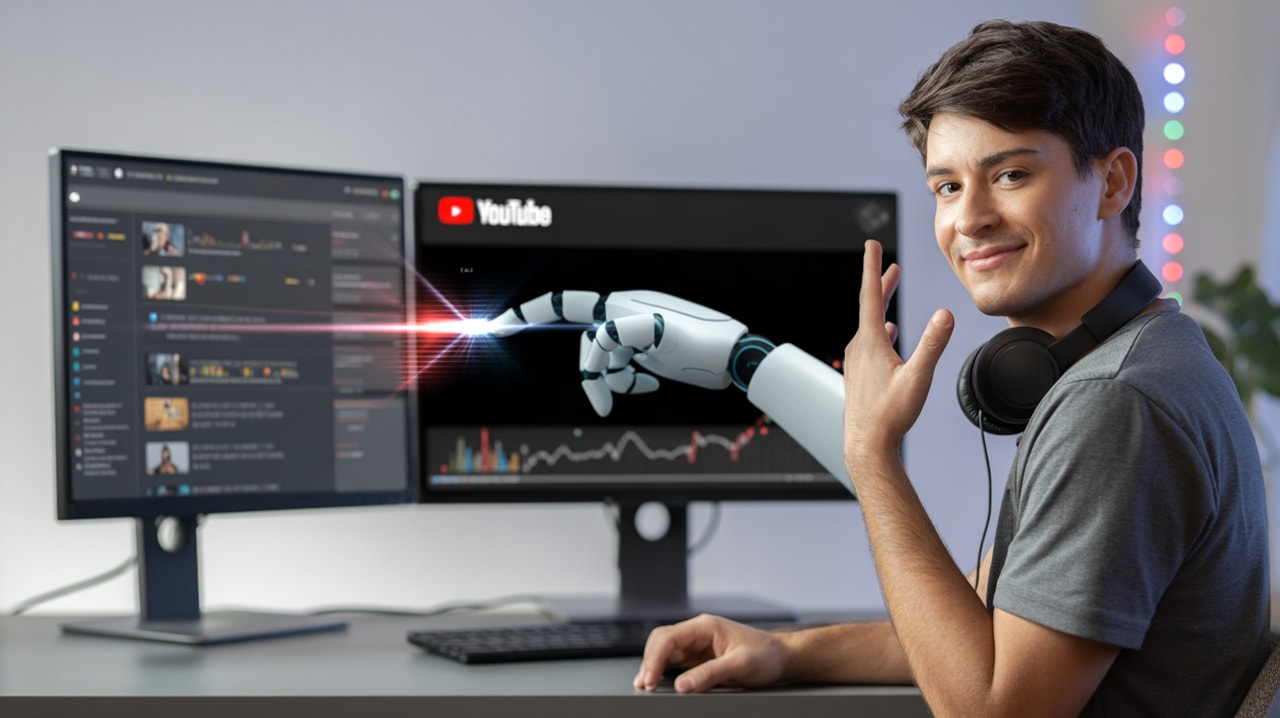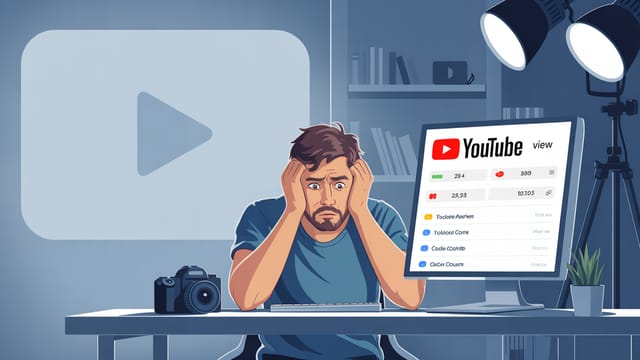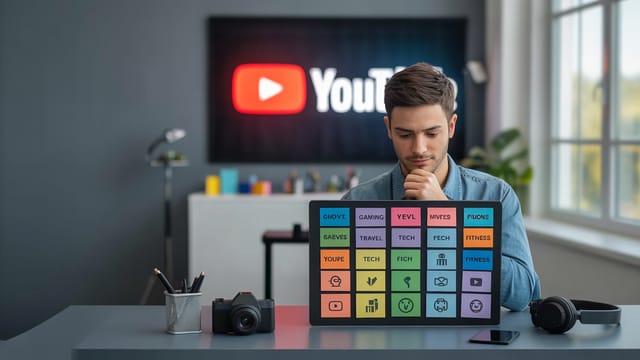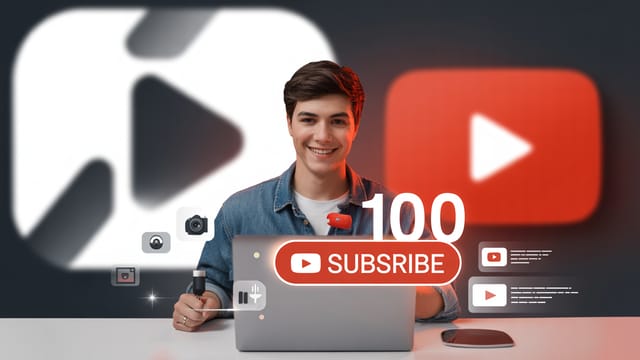
Ready to get your next 10,000 subscribers?
Join thousands of creators who use Subscribr to create faster, better YouTube videos.
What is AI YouTube Automation? (And Is It Right For Your Channel?)
The buzz around Artificial Intelligence is everywhere, and YouTube is no exception. Creators are constantly hearing about "AI YouTube automation" and wondering if it's the key to effortless growth or a risky shortcut. But what exactly is it, how does it work, and is it something you should consider for your channel in 2025?
Let's break down the reality of AI YouTube automation, exploring its potential, its pitfalls, and the ethical questions it raises.
Defining AI YouTube Automation
At its core, AI YouTube automation refers to using artificial intelligence tools to perform tasks typically done manually in the YouTube content creation and management process. This isn't about pressing a single button and having an entire viral channel appear. Instead, it's about leveraging AI to streamline, accelerate, or even fully automate specific steps within your workflow.
Think of it as a spectrum, not an on/off switch. On one end, you have creators using AI to assist with tasks like brainstorming titles or suggesting tags – augmenting their existing process. On the other, you have "faceless" channels attempting to automate the entire creation pipeline, from scriptwriting and voiceovers to video editing, often with minimal human intervention after the initial setup.
The goal is usually efficiency: saving time, reducing costs, and potentially increasing output. However, the level of automation and the tools used can vary dramatically.
How AI is Being Used in YouTube Automation
AI tools are popping up for nearly every stage of the YouTube workflow. Here are some common applications:
- Idea Generation & Research: AI can analyze trending topics, search data, and competitor content to suggest video ideas or even draft initial research summaries.
- Script Writing: AI models can generate video scripts based on prompts. While often requiring significant human editing to match a channel's voice and structure, they can provide a starting point.
- Voiceovers: Voice cloning technology allows creators to generate audio narration from text using a sample of their own voice, or to use synthetic voices.
- Video Editing: Some AI tools can help automate tasks like adding b-roll footage based on script keywords, generating captions, or even creating basic cuts.
- Visuals & Thumbnails: AI can create graphics, background images, and even assist in designing thumbnail concepts, although the crucial "clickability" factor still heavily relies on human understanding of viewer psychology.
- Channel Management: AI can assist with tasks like generating video descriptions, suggesting tags, or even scheduling posts.
For tech-savvy creators and early adopters, experimenting with these tools offers a way to potentially work faster and test ideas more cheaply. As experts note, integrating AI strategically can help creators manage their time and attention better, reducing decision fatigue by assisting with certain steps in the process.
The Potential Benefits: Efficiency and Scale
The primary allure of AI YouTube automation lies in its potential to dramatically improve workflow automation and efficiency.
- Increased Output: By automating repetitive or time-consuming tasks like initial script drafts, voiceover recording, or basic editing, creators can potentially produce more videos in the same amount of time.
- Cost Reduction: For tasks that might have previously been outsourced (like voiceovers or basic editing), AI tools can offer a cheaper alternative.
- Faster Experimentation: Lowering the barrier to creation means creators can test more ideas, formats, and niches quickly to see what resonates with an audience. As one expert mentioned, AI lowers the cost of testing new ideas.
- Overcoming Bottlenecks: If a creator struggles with a specific part of the process, like writing engaging descriptions or finding relevant tags, AI can step in to provide assistance.
For many creators, especially those running multiple channels or trying to scale rapidly, the promise of a more efficient workflow is a powerful motivator. AI can augment human creativity, making creators more powerful, like a "cyborg" combining human intuition with machine speed.
The Risks and Drawbacks: Quality, Authenticity, and the Learning Curve
However, AI YouTube automation is far from a magic bullet. There are significant risks and drawbacks to consider.
- Steep Learning Curve: Effectively utilizing various AI platforms requires time and effort to learn. Each tool has its quirks, strengths, and limitations. Integrating them into a seamless workflow takes technical skill and experimentation. Simply knowing AI tools exist isn't enough; mastering them to produce high-quality content is the challenge.
- Lack of Authenticity: Content created predominantly by AI often lacks the unique personality, human touch, and lived experience that viewers connect with. While AI can mimic styles, it struggles to replicate genuine passion, humor, or vulnerability – the very elements that build trust and community. Relying too heavily on AI risks alienating your audience.
- Content Quality Issues: AI-generated content can sometimes be generic, repetitive, or even factually inaccurate. Scripts may lack depth or a compelling narrative arc. Voiceovers can sound robotic or unnatural. Editing might feel disjointed. Significant human oversight and refinement are almost always necessary to elevate AI output to a publishable standard.
- Market Saturation: The ease of creating basic content with AI could lead to an explosion of low-quality, similar-looking videos, making it harder for individual creators to stand out.
- Dependence on Tools: Becoming overly reliant on specific AI tools could pose problems if those tools change, become unavailable, or if YouTube's policies regarding AI-generated content evolve.
Navigating Copyright Issues and Ethical Dilemmas
One of the most significant pain points and key themes surrounding AI YouTube automation is navigating copyright issues and ethical dilemmas.
- Training Data Concerns: A major ethical question is whether the AI models used to generate content were trained on copyrighted material without proper permission or compensation to the original creators. There are concerns that platforms might use creator content to train AI models and then deploy AI agents that compete with those same creators.
- Disclosure and Transparency: Should creators disclose when content is AI-generated? While YouTube's policies are still evolving, transparency is crucial for maintaining viewer trust. Failing to disclose AI usage, especially if presenting synthetic content as human-created, is ethically questionable and could mislead your audience.
- Deepfakes and Misinformation: The ability of AI to generate realistic voice cloning and visuals raises serious concerns about the potential for creating deepfakes, impersonation, and spreading misinformation. Malicious actors could weaponize these tools for harmful purposes.
- Displacement of Human Talent: Increased automation, particularly in areas like scriptwriting, voiceovers, and editing, could potentially reduce the need for human professionals in these roles, raising economic and ethical questions about the future of creative work.
Responsible AI use on YouTube requires careful consideration of these issues. Creators must be mindful of the tools they use, understand the potential implications, and prioritize transparency with their audience. Building trust and authority through genuine human connection becomes even more critical in an age where AI can replicate surface-level content.
Can AI Run a YouTube Channel Automatically?
While AI tools can automate parts of the process, the idea of a fully autonomous AI running a successful YouTube channel from start to finish is largely science fiction at this point.
Even "faceless" channels that rely heavily on AI for scriptwriting, voiceovers, and visuals still require human input for:
- Strategy and Niche Selection: Identifying profitable niches and developing a content strategy requires human market understanding and creativity.
- Quality Control: Reviewing AI-generated content for accuracy, quality, and brand alignment is essential.
- Optimization: Crafting truly compelling titles and thumbnails that drive clicks often requires human creativity and understanding of viewer psychology, which can be augmented but not fully replaced by AI.
- Community Building: Responding to comments, engaging with viewers, and fostering a community is a fundamentally human activity that AI cannot replicate.
- Adaptation: The YouTube algorithm, viewer trends, and platform policies are constantly changing. Adapting to these shifts requires human analysis and strategic thinking.
While future advancements might bring us closer, currently, AI is best viewed as a powerful assistant or augmenter for human creators, not a replacement. The channels that will likely succeed are those where AI enhances human creativity and efficiency, rather than attempting to eliminate the human element entirely.
Is AI YouTube Automation Ethical?
The ethics of AI YouTube automation depend heavily on how it is used.
- Ethical Use: Using AI tools to streamline tasks, assist with research, improve accessibility (like automatic captions), or generate creative starting points is generally considered ethical, provided creators are transparent where necessary and respect copyright.
- Unethical Use: Using AI to mislead viewers (e.g., presenting synthetic content as original human work without disclosure), to generate harmful or misleading deepfakes, or to create content based on unethically sourced training data is unethical. Attempting to fully automate a channel in a way that bypasses genuine human connection and community building could also be seen as ethically questionable by viewers seeking authentic interactions.
Responsible AI use on YouTube means prioritizing transparency, respecting intellectual property, and using AI to enhance human creativity and connection, not replace it. For tech-savvy creators, understanding these ethical boundaries is just as important as mastering the tools themselves. It's about setting up ethical AI automation workflows that benefit both the creator and the viewer.
Hypothetical Impact on Watch Time
While a specific case study with a named channel and percentage increase is difficult to verify with current tools, we can explore how AI could hypothetically impact metrics like watch time based on its potential applications:
AI could potentially increase watch time by:
- Improving Script Quality: AI-assisted scriptwriting, particularly when refined by a human, could lead to more engaging, well-structured narratives that keep viewers watching longer.
- Enhancing Production Value: Automated editing tasks or AI-generated visuals could make videos look more polished and professional, reducing viewer drop-off.
- Optimizing Hooks and Titles: AI tools can help brainstorm and refine video titles and hooks, leading to higher click-through rates and ensuring viewers stay past the critical first few seconds.
- Increasing Consistency: By streamlining workflows, AI can help channels maintain a more consistent upload schedule, which can positively impact watch time over time.
However, if AI is used to produce low-quality, generic, or inauthentic content, it could easily decrease watch time as viewers click away from videos they don't find engaging or trustworthy. The impact on watch time ultimately depends on how effectively AI is integrated and the quality of the final output.
Is AI YouTube Automation Right For Your Channel?
Deciding whether to incorporate AI into your YouTube workflow depends on your goals, technical comfort level, and willingness to navigate the ethical considerations.
AI automation might be right for you if:
- You are a tech-savvy creator eager to experiment with new tools.
- You are struggling with specific, repeatable tasks in your workflow that AI could potentially automate (like initial research or drafting descriptions).
- You want to increase your content output or test new ideas more quickly.
- You are committed to maintaining quality, authenticity, and transparency with your audience, even when using AI.
- You are prepared to invest time in learning new platforms and refining AI outputs.
AI automation might not be right for you if:
- You prioritize a deeply personal, human-led connection with your audience above all else.
- You are uncomfortable with the ethical ambiguities and copyright issues surrounding AI training data.
- You are not interested in spending time learning and integrating new technical tools.
- You are looking for a "get rich quick" scheme or a way to avoid the hard work of content creation and community building.
Ultimately, AI is a tool. Like any tool, its effectiveness and ethical implications depend on the hands that wield it. For tech-savvy creators, exploring AI's potential for workflow automation and efficiency while prioritizing responsible use is a smart move in 2025.
Tools & Resources
Platforms like Subscribr are designed to help creators leverage AI effectively within their YouTube workflow. Subscribr's AI Script Writer, Research Assistant, and Channel Intelligence features are built specifically for YouTube, helping creators with everything from finding viral topics and researching content to writing optimized scripts and analyzing channel performance. Unlike generic AI tools, Subscribr provides a purpose-built environment for YouTube creators looking to ethically integrate AI into their process and build sustainable channels.
Conclusion
AI YouTube automation is a rapidly evolving landscape offering exciting possibilities for efficiency and scale. However, it also presents significant challenges related to learning curves, maintaining authenticity, navigating copyright, and upholding ethical standards.
For tech-savvy creators willing to learn and experiment responsibly, AI can be a powerful ally, augmenting their abilities and streamlining tasks. But it's not a substitute for human creativity, genuine connection, or strategic thinking. The most successful channels will likely be those that use AI to enhance the human elements of their content, building trust, authority, and community in an increasingly automated world.
As a creator, understanding what AI YouTube automation truly means, exploring its potential applications, and carefully considering the ethical implications will be crucial for navigating the future of the platform. For those interested, offering consulting on setting up ethical AI automation workflows could even become a valuable monetization angle, helping other creators adopt these tools responsibly.





